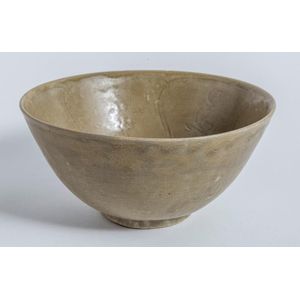Chinese Yue Celadon Incised Bowl, Northern Song Dynasty, Provenance Hochstadter
A Chinese Yue celadon incised bowl, Northern Song Dynasty (960-1127). Provenance: The Estate of the late Walter Hochstadter and Alice Chu, acquired by Walter Hochstadter prior to 1997 hence by descent. Walter Hochstadter was a well known and distinguished dealer of Chinese Art, born in Krumbach (Germany) in 1914. In the late 1930's he emigrated to the United States and died in Melbourne, Australia in 2007. He was a member of the Oriental ceramic Society (USA) from 1953-1982. A large number of the Hochstadter Collection was sold at Christies New York, 18th/19th March 2009, with a piece lot 518 reaching 2 million US dollars, 29.5 cm diameter
You must be a subscriber, and be logged in to view price and dealer details.
Subscribe Now to view actual auction price for this item
When you subscribe, you have the option of setting the currency in which to display prices to $Au, $US, $NZ or Stg.
This item has been sold, and the description, image and price are for reference purposes only.
- Incised - A record of a name, date or inscription, or a decoration scratched into a surface, usually of a glass or ceramic item with a blunt instrument to make a coarse indentation. Compare with engraving where the surface is cut with a sharp instrument such as a metal needle or rotating tool to achieve a fine indentation.
- Song Dynasty - The Song Dynasty was a ruling dynasty in China from 960 to 1279 AD. It was divided into two periods, the Northern Song (960?1127) and the Southern Song (1127?1279). The emperor was the ultimate authority, but he relied on officials who were selected based on their merit and skills rather than their family background or social status. The Song Dynasty was a period of great artistic and cultural achievements, particularly in the areas of poetry, painting, and calligraphy. The Chinese invented the printing press during this period, which revolutionized the spread of knowledge and ideas. During the Song Dynasty, China had a prosperous economy and was a centre of international trade, particularly in luxury goods such as silk, tea, and porcelain. The use of paper money became more widespread during this period, facilitating commerce and trade.
This item has been included into following indexes:
-
Chinese antiquities by dynasty
- Northern Dynasties 119
- Song Dynasty 648
